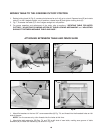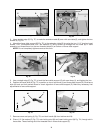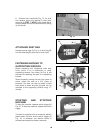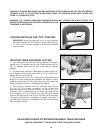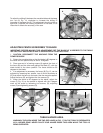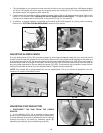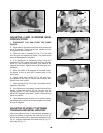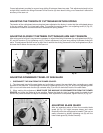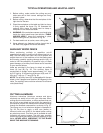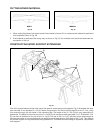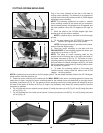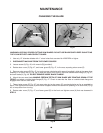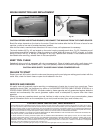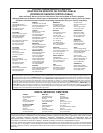
1414
Correct adjustment provides for a good snug sliding fit between these two parts. This adjustment should not be
so tight that it restricts the tilting movement of the trunnion (A) when bevel cutting, or so loose that it affects the
accuracy of the saw cut.
ADJUSTING THE TENSION OF CUTTINGHEAD RETURN SPRING
The tension of the cuttinghead return spring has been adjusted at the factory in order that the cuttinghead returns
to the up position after a cut has been made. To re-adjust the spring tension, turn adjusting screw (A) Fig. 32,
clockwise to increase or counterclockwise to decrease the spring tension.
ADJUSTING SLIDING FIT BETWEEN CUTTINGHEAD ARM AND TRUNNION
After a long period of time it may become necessary to adjust the sliding fit between the cuttinghead arm (B) Fig.
32, and the trunnion (C) by tightening nut (D). Correct adjustment is a good snug sliding fit between these two
parts. This adjustment should not be so tight that it restricts the sliding movement of the cuttinghead arm (B) or
so loose that it affects the accuracy of the saw cut.
ADJUSTING DOWNWARD TRAVEL OF SAW BLADE
1. DISCONNECT THE SAW FROM THE POWER SOURCE.
2. The downward travel of the saw blade can be limited to prevent the saw blade from contacting any metal
surfaces of the machine. This adjustment is made by loosening locknut (A) Fig. 33, and turning adjusting screw
(B) in or out until other end of screw (B) contacts stop (C) at the full downward travel of the saw blade.
3. When making this adjustment, MAKE SURE THE MACHINE IS DISCONNECTED FROM THE POWER
SOURCE and lower the blade as far as possible. Rotate the blade by hand to make certain the teeth do not
contact any metal surfaces and adjust if necessary. After adjustment is completed, tighten locknut (A) Fig. 33.
ADJUSTING BLADE GUARD
After an extended period of time the movable blade
guard (A) Fig. 34, might become sloppy and move
erratically when the cuttinghead is lowered. This can be
easily corrected by slightly tightening nut (B) until the
lower blade guard (A) moves smoothly.
Fig. 34
A
B
Fig. 33
B
A
A
C
B
C
D
Fig. 32



